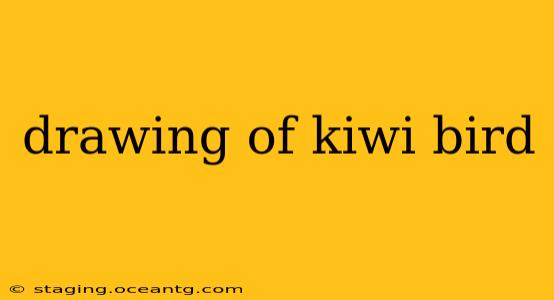The kiwi, New Zealand's national bird, is a fascinating creature with unique features that make it a captivating subject for artists. Its flightless nature, distinctive long beak, and fuzzy brown feathers offer a wealth of artistic possibilities. Whether you're a seasoned artist or just starting out, this guide will help you master the art of drawing a kiwi bird.
What Makes a Kiwi Bird Unique? Understanding Your Subject
Before you begin, it's essential to understand the kiwi's anatomy. This knowledge will inform your drawing and allow you to capture its essence accurately. Key features to focus on include:
- The Beak: The kiwi's long, slender beak is its most striking feature. Note its slightly curved shape and the nostrils located near the tip.
- The Body: The kiwi's body is stout and round, almost pear-shaped. Its legs are relatively short and sturdy.
- The Feathers: Unlike many birds, kiwi feathers resemble fur. They are dense and soft, giving the bird a fluffy appearance.
- The Eyes: Kiwi eyes are small and dark, adding to their mysterious charm.
Step-by-Step Guide to Drawing a Kiwi Bird
Let's break down the process into manageable steps:
1. Basic Shapes: Start by sketching basic shapes to outline the kiwi's body. Use an oval for the body and a slightly curved line for the beak. Add small circles for the eyes and short lines for the legs.
2. Refining the Body: Gradually refine the oval into the kiwi's more rounded shape. Pay attention to the curve of the back and the fullness of the breast.
3. Detailing the Beak: Carefully draw the kiwi's beak, paying close attention to its length, curve, and the placement of the nostrils.
4. Adding the Legs: Sketch in the kiwi's short, sturdy legs. Note the position of the feet and toes.
5. Feather Texture: This is where you can bring your kiwi to life. Instead of individual feathers, focus on suggesting the texture of the fluffy plumage. Use short, slightly overlapping strokes to create a sense of depth and softness. Vary the pressure on your pencil to create areas of light and shadow.
6. Eyes and Details: Add the small, dark eyes. You can add subtle details like wrinkles around the beak or slight variations in the feather texture to enhance realism.
7. Shading and Highlights: Use shading to give your kiwi a three-dimensional form. Observe where light would naturally fall on the bird's body and use shading to create shadows and highlights. This will add depth and realism to your drawing.
What are the different types of Kiwi birds?
There are five species of kiwi, each with slightly different characteristics:
- Brown Kiwi (Apteryx australis): The most common type, with brown feathers and a relatively large beak.
- Little Spotted Kiwi (Apteryx owenii): The smallest kiwi species, with speckled brown feathers.
- Great Spotted Kiwi (Apteryx haastii): A larger species with speckled brown feathers and a longer beak than the Little Spotted Kiwi.
- North Island Brown Kiwi (Apteryx mantelli): A brown kiwi subspecies found on the North Island of New Zealand.
- Okarito Kiwi (Apteryx rowi): A critically endangered kiwi species with dark brown feathers.
These differences are subtle, but an observant artist might choose to incorporate them into their drawing. For example, the size of the beak or the density of the feathers can be adjusted to depict a specific kiwi species.
How can I make my kiwi drawing more realistic?
Achieving realism in your kiwi drawing involves paying close attention to detail and understanding light and shadow. Referencing photographs of kiwis will significantly enhance your ability to capture accurate proportions and textures. Practicing your shading techniques will allow you to create a more three-dimensional effect.
What materials are best for drawing a kiwi?
While you can use various materials, pencils offer excellent versatility for both sketching and adding detail. Experiment with different grades of pencils (e.g., H, 2B, 4B) to achieve a range of values in your drawing. Eraser is essential for correcting mistakes and refining lines.
Drawing a kiwi is a rewarding experience. By focusing on the bird's unique characteristics and practicing your drawing skills, you can create a beautiful and lifelike representation of this iconic New Zealand bird. Remember to observe carefully, practice regularly, and have fun!
